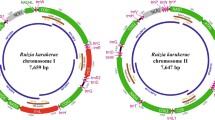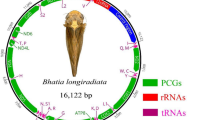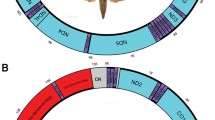Abstract
The complete mitochondrial genome of Pseudochauhanea macrorchis was determined and compared with other monogenean mitochondrial genomes from GenBank. The circular genome was 15,031 bp in length and encoded 36 genes (12 protein-coding genes, two ribosomal RNAs, and 22 transfer RNAs) typically found in flatworms. Structures of the mitochondrial genome were mostly concordant with that known for Microcotyle sebastis and Polylabris halichoeres, but also contained two noted features—a gene rearrangement hot spot and the highly repetitive region (HRR) in major non-coding region (NCR). The gene rearrangement hot spot located between the cox3 and nad5 genes, including a cluster of tRNA genes, nad6 gene and one major NCR. The HRR seemed to be a unique feature of the polyopisthocotylean mitochondrial genomes. In conclusion, the present study provided new molecular data for future studies of the comparative mitochondrial genomics and also served as a resource of markers for the studies of species populations and monogenean phylogenetics.





Similar content being viewed by others
References
Piganeau G, Gardner M, Eyre-Walker A (2004) A broad survey of recombination in animal mitochondria. Mol Biol Evol 21:2319–2325. doi:10.1093/molbev/msh244
Xia X (2005) Mutation and selection on the anticodon of tRNA genes in vertebrate mitochondrial genomes. Gene 345:13–20. doi:10.1016/j.gene.2004.11.019
Kamatani T, Yamamoto T (2007) Comparison of codon usage and tRNAs in mitochondrial genomes of Candida species. Biosystems 90:362–370. doi:10.1016/j.biosystems.2006.09.039
Boore JL, Macey JR, Medina M (2005) Sequencing and comparing whole mitochondrial genomes of animals. Methods Enzymol 395:311–348. doi:10.1016/S0076-6879(05)95019-2
Boore JL (2006) The use of genome-level characters for phylogenetic reconstruction. Trends Ecol Evol 21:439–446. doi:10.1016/j.tree.2006.05.009
Lei R, Shore GD, Brenneman RA, Engberg SE, Sitzmann BD, Bailey CA, Kimmel LM, Randriamampionona R, Ranaivoarisoa JF, Louis EE (2010) Complete sequence and gene organization of the mitochondrial genome for Hubbard’s sportive lemur (Lepilemur hubbardorum). Gene 464:44–49. doi:10.1016/j.gene.2010.06.001
Wei S, Shi M, He J, Sharkey M, Chen X (2009) The complete mitochondrial genome of Diadegma semiclausum (Hymenoptera: Ichneumonidae) indicates extensive independent evolutionary events. Genome 52:308–319. doi:10.1139/G09-008
Masta SE, Boore JL (2004) The complete mitochondrial genome sequence of the spider Habronattus oregonensis reveals rearranged and extremely truncated tRNAs. Mol Biol Evol 21:893–902. doi:10.1093/molbev/msh096
Dermauw W, Vanholme B, Tirry L, Leeuwen TV (2010) Mitochondrial genome analysis of the predatory mite Phytoseiulus persimilis and a revisit of the Metaseiulus occidentalis mitochondrial genome. Genome 53:285–301. doi:10.1139/G10-004
Chen HX, Sundberg P, Wu HY, Sun SC (2010) The mitochondrial genomes of two nemerteans, Cephalothrix sp. (Nemertea: Palaeonemertea) and Paranemertes cf. peregrina (Nemertea: Hoplonemertea). Mol Biol Rep 38(7):4509–4525. doi:10.1007/s11033-010-0582-4
Zhang DX, Hewitt GM (1997) Insect mitochondrial control region: a review of its structure, evolution and usefulness in evolutionary studies. Biochem Syst Ecol 25:99–120. doi:10.1016/S0305-1978(96)00042-7
Boore JL (1999) Animal mitochondrial genomes. Nucl Acids Res 27:1767–1780. doi:10.1093/nar/27.8.1767
Kolpakov R, Bana G, Kucherov G (2003) Mreps: efficient and flexible detection of tandem repeats in DNA. Nucl Acids Res 31:3672–3678. doi:10.1093/nar/gkg617
Lukić-Bilela L, Brandt D, Pojskić N, Wiens M, Gamulin V, Müller WEG (2008) Mitochondrial genome of Suberites domuncula: palindromes and inverted repeats are abundant in non-coding regions. Gene 412:1–11. doi:10.1016/j.gene.2008.01.001
Le TH, Blair D, McManus DP (2002) Mitochondrial genomes of parasitic flatworms. Trends Parasitol 18(5):206–213. doi:10.1016/S1471-4922(02)02252-3
Bourlat SJ, Rota-Stabelli O, Lanfear R, Telford MJ (2009) The mitochondrial genome structure of Xenoturbella bocki (phylum Xenoturbellida) is ancestral within the deuterostomes. BMC Evol Biol 9:107. doi:10.1186/1471-2148-9-107
Mjelle KA, Karlsen BO, Jorgensen TE, Moum T, Johansen SD (2008) Halibut mitochondrial genomes contain extensive heteroplasmic tandem repeat arrays involved in DNA recombination. BMC Genom 9:10. doi:10.1186/1471-2164-9-10
Park JK, Kim KH, Kang S, Kim W, Eom KS, Littlewood DTJ (2007) A common origin of complex life cycles in parasitic flatworms: evidence from the complete mitochondrial genome of Microcotyle sebastis (Monogenea: Platyhelminthes). BMC Evol Biol 7:11. doi:10.1186/1471-2148-7-11
Littlewood DTJ, Lockyer AE, Webster BL, Johnston DA, Le TH (2006) The complete mitochondrial genomes of Schistosoma haematobium and Schistosoma spindale and the evolutionary history of mitochondrial genome changes among parasitic flatworms. Mol Phylogenet Evol 39:452–467. doi:10.1016/j.ympev.2005.12.012
von Nickisch-Rosenegk M, Brown WM, Boore JL (2001) Complete sequence of the mitochondrial genome of the tapeworm Hymenolepis diminuta: gene arrangements indicate that platyhelminths are Eutrochozoans. Mol Biol Evol 18(5):721–730
Shen X, Wang H, Ren J, Tian M, Wang M (2010) The mitochondrial genome of Euphausia superb (Prydz Bay) (Crustacea: Malacostraca: Euphausiacea) reveals a novel gene arrangement and potential molecular markers. Mol Biol Rep 37:771–784. doi:10.1007/s11033-009-9602-7
Webster BL, Mackenzie-Dodds JA, Telford MJ, Littlewood DTJ (2007) The mitochondrial genome of Priapulus caudatus Lamarck (Priapulida: Priapulidae). Gene 389:96–105. doi:10.1016/j.gene.2006.10.005
Zhang JY, Qiu ZZ, Ding XJ (1999) Parasites and parasitic diseases of fishes. Science Press, Beijing (In Chinese)
Larkin MA, Blackshields G, Brown NP, Chenna R, McGettigan PA, McWilliam H, Valentin F, Wallace IM, Wilm A, Lopez R, Thompson JD, Gibson TJ, Higgins DG (2007) Clustal W and clustal X version 2.0. Bioinformatics 23:2947–2948. doi:10.1093/bioinformatics/btm404
Lowe T, Eddy S (1997) tRNAscan-SE: a program for improved detection of transfer RNA genes in genomic sequence. Nucl Acids Res 25:955–964. doi:10.1093/nar/25.5.0955
Benson G (1999) Tandem repeats finder: a program to analyze DNA sequences. Nucl Acids Res 27:573–580. doi:10.1093/nar/27.2.573
Stothard P, Wishart DS (2005) Circular genome visualization and exploration using CGView. Bioinformatics 21:537–539. doi:10.1093/bioinformatics/bti054
Tamura K, Dudley J, Nei M, Kumar S (2007) MEGA4: molecular evolutionary genetics analysis (MEGA) software version 4.0. Mol Biol Evol 24:1596–1599. doi:10.1093/molbev/msm092
Wang S, Lei Z, Wang H, Dong B, Ren B (2011) The complete mitochondrial genome of the leafminer Liriomyza trifolii (Diptera: Agromyzidae). Mol Biol Rep 38:687–692. doi:10.1007/s11033-010-0155-6
Yang Z, Bielawski JP (2000) Statistical methods for detecting molecular adaptation. Trends Ecol Evol 15(12):496–503. doi:10.1016/S0169-5347(00)01994-7
Wolstenholme DR (1992) Animal mitochondrial DNA: structure and evolution. Int Rev Cytol 141:173–216. doi:10.1016/S0074-7696(08)62066-5
Zhang J, Wu XY, Xie MQ, Xu XD, Li AX (2011) The mitochondrial genome of Polylabris halichoeres (Monogenea: Microcotylidae). Mitochondr DNA 22:3–5. doi:10.3109/19401736.2011.588223
Boore JL, Brown WM (1998) Big trees from little genomes: mitochondrial gene order as a phylogenetic tool. Curr Opin Genet Dev 8:668–674. doi:10.1016/S0959-437X(98)80035-X
Acknowledgments
This work was financially supported by National Natural Science Foundation of China (grant No. 30871934) and Key Projects in the National Science & Technology Pillar Program (grant No. 2007BAD29B05).
Author information
Authors and Affiliations
Corresponding author
Rights and permissions
About this article
Cite this article
Zhang, J., Wu, X., Xie, M. et al. The complete mitochondrial genome of Pseudochauhanea macrorchis (Monogenea: Chauhaneidae) revealed a highly repetitive region and a gene rearrangement hot spot in Polyopisthocotylea. Mol Biol Rep 39, 8115–8125 (2012). https://doi.org/10.1007/s11033-012-1659-z
Received:
Accepted:
Published:
Issue Date:
DOI: https://doi.org/10.1007/s11033-012-1659-z




